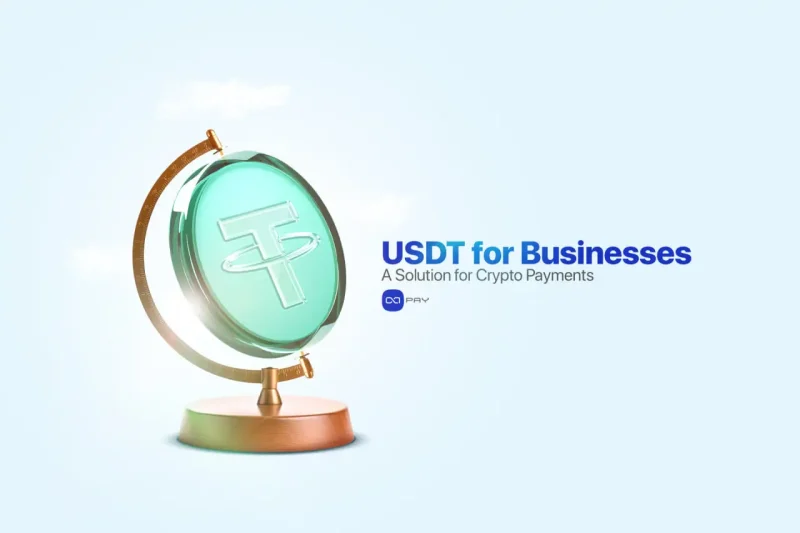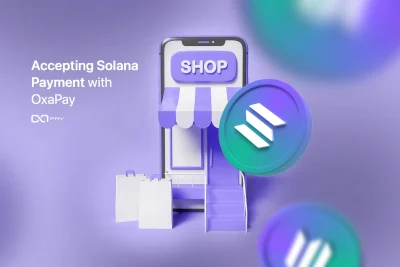Looking to accept crypto payments without dealing with price volatility or banking restrictions? USDT (Tether) is a stablecoin pegged to the U.S. dollar, offering businesses a fast, secure, and reliable way to receive payments worldwide. In this article, we’ll explore how USDT works, why it’s ideal for commercial use, and how the OxaPay USDT payment gateway makes adoption seamless and hassle-free.
What Is Tether (USDT) and How Does It Work?
Tether (USDT) is a stablecoin, a type of cryptocurrency designed to maintain a fixed value of approximately $1 USD. Unlike volatile coins like Bitcoin or Ethereum, USDT offers price stability, making it suitable for everyday business use. Issued by Tether Ltd., each USDT is backed by cash or equivalent assets held in reserve. This 1:1 backing ensures confidence and liquidity. USDT operates on major blockchains including Tron, Ethereum, BNB Chain, Polygon, and Solana, allowing for fast and borderless transactions.
USDT Market Snapshot (as of July 2025):
| Metric | Value |
| Circulating Supply | 160+ billion USDT |
| Daily Trading Volume | Over $116 billion |
| Stablecoin Market Share | Over 60% |
As a stablecoin, Tether helps connect traditional financial systems with digital assets.
Key Features of USDT for Businesses
USDT offers a unique combination of benefits that make it ideal for business use. Its stability, speed, and global accessibility simplify accounting, settlements, and cross-border operations.
Top USDT features for businesses:
- Always pegged to $1, making it ideal for invoicing and accurate bookkeeping
- Enables instant settlements, even on weekends or holidays
- Can be used globally without needing a bank account or international credit card
- Offers very low transaction fees, especially on networks like Tron (TRC-20) or Polygon
- Compatible with various wallets and crypto payment gateways such as OxaPay
📌 Note: For businesses earning in USD or working with international clients, USDT is a reliable and accessible financial tool.
USDT’s Role and Achievements in Global Commerce
Tether isn’t just another stablecoin, it’s a foundational asset in digital finance. From crypto exchanges and B2B settlements to Web3 apps, USDT plays a central role across the ecosystem.
USDT’s importance in the global financial system:
- Highest trading volume among all stablecoins
- Supported by thousands of platforms, exchanges, and payment gateways
- Widely used in OTC settlements and international B2B payments
- Common in Web3 games, DeFi protocols, and NFT marketplaces
✅ Conclusion: USDT has become the “digital dollar” of the crypto world, combining trust, scalability, and efficiency.
Comparing USDT to Other Stablecoins
| Feature | USDT | USDC | DAI |
| Issuer | Tether Ltd. | Circle | MakerDAO |
| Collateral type | USD & cash assets | USD & government bonds | Crypto collateral |
| Adoption level | Very high | High | Moderate |
| Best for | Payments, commerce, daily use | Fintech & regulated apps | DeFi users |
📌 Insight: For payments and commercial settlements, USDT remains the top choice among businesses.

Use Cases of Tether in Business and Commerce
Tether (USDT) is more than just a digital currency, it’s a modern financial tool used in operations, settlements, and global business. Its combination of price stability, speed, and global reach makes it suitable across industries.
Invoicing & Cross-Border Settlements
Businesses dealing with international clients often face delays and banking limitations.
- Issue dollar invoices, receive USDT instantly
- Faster than SWIFT or PayPal
- No need for foreign bank accounts
📌 Example: A Turkish agency bills a German client; payment in USDT (TRC-20) settles in seconds.
Avoiding Banking Restrictions
In regions with sanctions or weak banking systems, USDT offers access to the global economy.
- Accept payments from restricted countries
- Pay teams abroad without relying on traditional banks
📌 Note: For businesses in Afghanistan or Venezuela, USDT enables participation in global trade.
Paying Freelancers & Contractors
Remote teams benefit from stable, fast, and low-fee payments.
For employers:
- No complex paperwork
- Transparent on-chain records
For freelancers:
- Quick access to funds
- No need for foreign bank accounts
Holding Stable Revenue
USDT’s dollar peg protects revenue from crypto volatility.
- Accept USDT
- Hold or convert when needed
📌 Tip: OxaPay offers an internal Swap feature that allows merchants to automatically convert BTC or other crypto payments into USDT. This process is instant, secure, and does not require additional blockchain fees, ensuring revenue remains stable.
B2B Settlements
For business-to-business transactions, USDT enables fast, traceable, low-cost settlements.
- Transparent on-chain transactions
- Instant payment confirmation
📌 Example: A Chinese supplier is paid by an Indian buyer in USDT, no banks involved.
In-App & Subscription Payments
Ideal for SaaS platforms, games, or content apps with recurring or micro-transactions.
- Monthly billing or credit top-ups
- No credit cards required
- High-speed and secure
Benefits of Using Tether in Business
Thanks to its price stability and digital-native format, USDT offers a number of distinct benefits, especially for businesses in e-commerce or global operations.
Key advantages include:
- Simplified accounting: Its 1:1 USD value removes the need for volatility-adjusted profit/loss tracking
- Transparent transactions: All payments are recorded on the blockchain and easily auditable
- 24/7 Instant settlement: No banks, no downtime, payments process within seconds
- Low fees: Especially compared to international wires or SWIFT-based systems
- Greater trust from international clients: Dollar-based payments without the need for international cards
Risks and Challenges of Using USDT
While USDT is a powerful business tool, it’s not without risk. Being aware of potential issues, and using the right tools, can mitigate many of them.
Common concerns include:
- ⚠️ Lack of deposit insurance: Unlike bank deposits, USDT holdings are not covered by government-backed protection schemes.
- ⚠️ Variable network fees: Selecting high-cost blockchains (e.g., Ethereum) can increase transaction costs.
- ⚠️ User familiarity: Some customers may require guidance to understand and use stablecoin payments effectively.
📌 Recommended Solution: Use professional payment gateways like OxaPay, which provide user-friendly interfaces, optimized blockchain selection for lower costs, and clear guidance to simplify the customer experience.
What Types of Businesses Can Use USDT?
Your business doesn’t need to be in the crypto industry to benefit from Tether. In fact, many companies adopt USDT purely for its operational and financial utility.
Ideal businesses for USDT acceptance:
- Businesses with international customers or cross-border payments
- Companies seeking USD-based income or conversions
- Teams needing fast daily settlements
- Merchants facing high banking or wire fees
- Companies working with freelancers or foreign contractors
- Platforms with digital, online financial flows
✅ If your business operates online and serves a global audience, accepting USDT can streamline your finances, faster, cheaper, and easier.
USDT as a Payment Method
USDT provides a fast, stable, and borderless alternative to traditional payment methods. Customers can pay using a simple crypto wallet, no banks, credit cards, or KYC needed. This removes friction in global transactions and improves checkout experience.
Key Benefits:
- Dollar-based payments without credit cards
- No currency or country restrictions
- Quick payments via wallet or exchange
- Confirmations within seconds
📦 Tip: Accepting USDT in WooCommerce or mobile apps can boost conversions and remove international barriers.
Comparing USDT to Other Payment Methods
Businesses can choose between traditional methods like credit cards and newer ones like Bitcoin. USDT offers a rare combination: blockchain efficiency with price stability, ideal for commercial use.
| Feature | Tether (USDT) | Bitcoin (BTC) | International Bank Card | PayPal |
| Price Stability | ✅ Yes | ❌ Volatile | ✅ Stable | ✅ Stable |
| Settlement Speed | ✅ Seconds | ❌ Slow | ✅ Instant | ✅ Instant |
| Requires Bank Account | ❌ No | ❌ No | ✅ Yes | ✅ Yes |
| Fees | 🔶 Low | 🔶 Variable | ❌ High | ❌ High |
| Reversibility | ❌ No | ❌ No | ✅ Partial | ✅ Yes |
| Global Acceptance | ✅ Growing | ✅ Growing | ❌ Limited | ❌ Limited |
📦 Business Insight:
For dollar-based payments without a bank, yet with the speed and accessibility of crypto, USDT stands out as the most practical option.

Best Blockchains for Accepting USDT
USDT runs on several blockchains, each with its own speed, cost, and compatibility. The network you choose directly impacts fees and performance.
| Blockchain | Transfer Fee | Confirmation Speed | Popularity for Payments | Best For |
| Tron (TRC-20) | Very low | Very fast | ✅ Very high | Online stores, freelancers |
| Ethereum (ERC-20) | High | Moderate–High | ✅ High | Enterprises, DeFi projects |
| BNB Smart Chain | Low | Fast | ✅ Medium | E-commerce platforms |
| Polygon | Very low | Very fast | ✅ Growing | Gaming, NFT platforms |
| Solana (SPL) | Very low | Ultra-fast | ✅ Rapid growth | Micro and instant payments |
| TON | Very low | Fast | ✅ Emerging | In-app, Telegram-based payments |
| Arbitrum | Medium | Very fast | ✅ DeFi Popular | Advanced DeFi users |
📦 Tip for Businesses:
For businesses searching for the Best Blockchain for Accepting USDT Payments, TRC-20, Solana, or Polygon are ideal for fast, low-fee transactions, while Ethereum or Arbitrum work best for DeFi and smart contract tools.
How to Integrate USDT Payments in Your Business
Setting up USDT payments for your business is fast and easy. First, choose a crypto payment gateway like OxaPay that supports USDT on popular blockchains. Next, connect it to your website or app using plugins (e.g., WooCommerce) or APIs. Then, configure your preferred settings, such as accepted networks, auto-conversion, and wallet address. Finally, run a test transaction and go live. You’ll be ready to receive Tether from customers around the world in minutes.
📌 Tip: No website? No problem. Use no-code options like Payment Links to start accepting USDT instantly, without any development
Introducing OxaPay as a USDT Payment Gateway
OxaPay is a professional USDT payment gateway that enables businesses to accept crypto payments fast, securely, and without KYC. With multi-network support and intuitive tools, OxaPay simplifies payment operations for both merchants and customers.
Key Features for USDT Acceptance:
- Multi-network support: TRC-20, ERC-20, Polygon, BEP-20, TON
- Instant settlement and low fees , no banking delays
- Full dashboard for invoicing, analytics, and transaction tracking
- No-code tools: Payment Link, Merchant POS
- Merchant services: Invoice, White Label, Static Address
- Plugins: WooCommerce, WHMCS, Blesta, and more
- Flexible API and documentation for custom integrations
- No KYC or foreign bank account required
📌 Competitive Edge:
Compared to other gateways, OxaPay offers lower fees, greater flexibility, and full control over networks, settlements, and user experience.
📦 Practical Example:
A SaaS store connects the OxaPay WooCommerce plugin, starts receiving USDT from global users instantly, and manages revenue on their preferred network, all without needing a foreign bank account.
How to Start Accepting USDT with OxaPay
Setting up OxaPay takes just a few minutes and requires no technical expertise:
- Sign up for free at OxaPay.com
- Select your preferred network (e.g., TRC-20 for low fees)
- Create or link your wallet
- Activate your preferred tool: Invoice, Payment Link, WooCommerce plugin, etc.
- Customize the setup and start receiving USDT payments
🎯 Get started now and activate USDT payments in your business, fast, secure, and no KYC needed.
Conclusion: Is USDT Right for Your Business?
If you’re looking for a dollar-based, fast, low-cost payment method with no banking restrictions, USDT is the best crypto solution for your business.
This stablecoin simplifies the sales process, payments, and financial management, making everything predictable and trustworthy.
With OxaPay crypto gateway, you don’t need technical skills or banking infrastructure.
Just sign up, connect your wallet, and start receiving dollar-equivalent payments from customers around the world.




